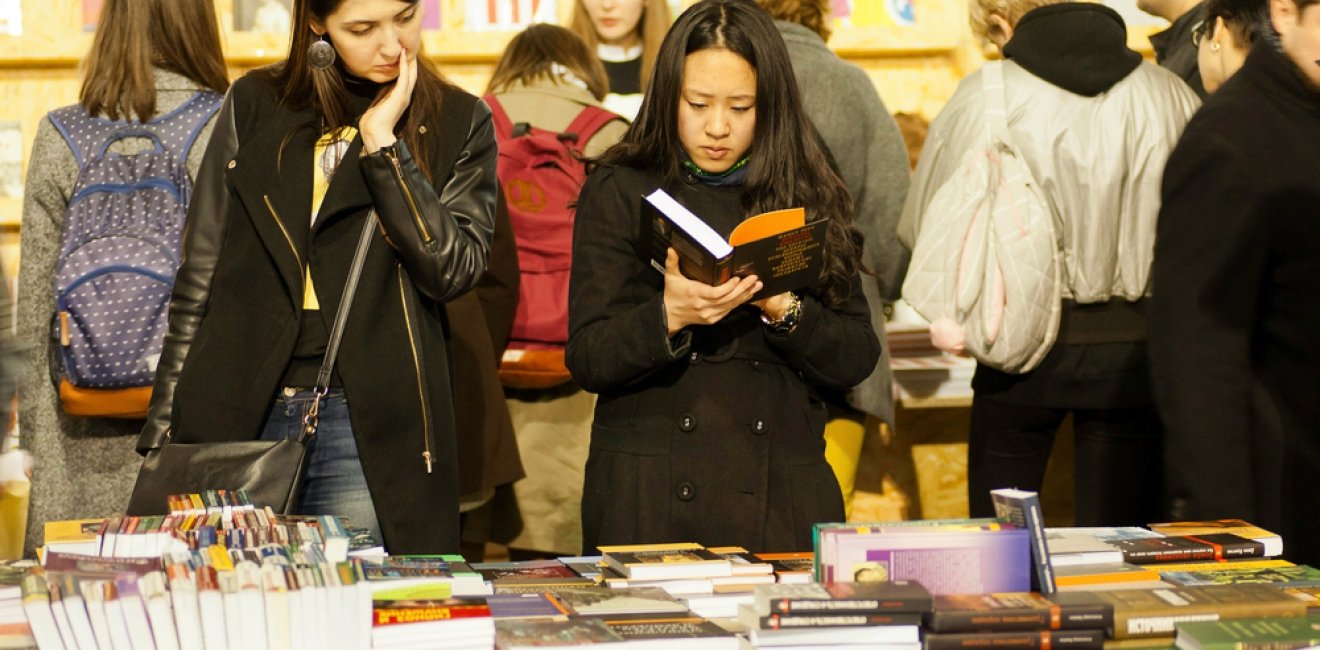
A blog of the Kennan Institute
For three days this June (22–25), hundreds of Kyiv’s writers, publishers, and book lovers celebrated the return of the Arsenal Book Fair despite the threat of Russian aerial bombardment. The annual book fair was launched in 2011 to stimulate book publishing and readership, to display new works, to integrate Ukrainian publishing into a larger international framework, and to provide a congenial space for publishers, writers, and readers to engage with one another. Housed in the monumental Mystetskyi Arsenal, Kyiv’s annual celebration of the book has offered an invaluable anchor for the city’s—and country’s—literary scene.
The arsenal’s history follows that of Kyiv itself over several centuries. The building sits on part of the Pechersk Lavra complex, which has drawn religious pilgrims since the 11th century. Russia’s Imperial government built the fortress at the turn of the 19th century on the site of the Voznesenskyi Pechersk female monastic community of the mid-16th century. Constructed of brick with enormous, six-foot-wide walls, the arsenal served as the site of munition and weapons manufacture. Changes in technology rendered its manufacturing capacity inadequate by the mid-19th century. The Russian, and Soviet, and Ukrainian armies subsequently used the gigantic complex as a weapons depot until the end of the 20th century.
In 2005, President Viktor Yushchenko converted the site into a national cultural, arts, and museum complex to promote the modernization of Ukrainian society and the integration of his country into the larger world. The Mystetskyi Arsenal National Art and Culture Museum Complex has evolved into one of Ukraine’s leading cultural centers, hosting exhibitions, festivals, educational projects, large-scale theatrical productions, and the country’s largest book fair.
The annual spring book fair has expanded with each iteration. By 2019, it was showcasing more than 150 Ukrainian publishers, and 500 writers from 50 countries. Beginning in 2017, each year’s fair focused on curated themes, such as “Laughter, Fear, Power” (2017), “The Project of the Future” (2018), and “Neighborhood: Open Discussion” (2019). COVID forced the 10th book fair, 2020’s “Optimists Skeptics,” to be put off until the spring of 2021. The Russian attack in February 2022 further disrupted the Arsenal’s operations.
The first task for museum director Olesia Ostrovska-Liuta and her staff following the invasion was to move the center’s permanent collection to safety. After several months, as initial martial law restrictions began to lift, the museum invited Kyiv artists to display work reflecting their wartime experiences. This exhibition, which opened in the autumn of 2022, encouraged visitors to add their own wartime experiences to a growing oral history archive. Other exhibits followed. In April, the Arsenal announced it would convene its 11th book fair this summer.
Journalist, author, and documentary filmmaker Nalaliya Gumenyuk curated this year’s fair around the theme, “When Everything Matters.” As she wrote for the fair’s publicity materials, “We are living in a time of aggravated reality when almost every word and every phrase acquires its original meaning. As if everything around is going through a reality check. In particular, our values and ideals.” She wanted to create a space where books create a new civic vocabulary for experiences that have yet to be verbalized. She invited writer Iryna Slavinska to direct the fair’s literary programs. Events included special children and teen programs.
Festival director Yulia Kozlovets told Publishing Perspectives (a global publishing business magazine launched in association with the Frankfurt Book Fair) that this year’s fair was a special war edition with three days instead of five, three stages with 50 events, and limited space for seating. A bomb shelter was ready in case of attack. This reduced format nonetheless offered a wide selection of books from a broad range of Ukrainian publishing houses. It also demonstrated how, Kozlovets notes, “when the country is in a state of war, our institution stays strong, and how more and more sustainable we become.”
The fair’s success offers yet another example of how Ukrainians remain determined to carry on despite the vicious Russian attacks. It also underscores the importance of the country’s writers and publishers for the Ukrainian future. They and their readers craft a more fulsome understanding of Ukraine with each new printed page.
The opinions expressed in this article are those solely of the author and do not reflect the views of the Kennan Institute.
Author

Former Wilson Center Vice President for Programs (2014-2017); Director of the Comparative Urban Studies Program/Urban Sustainability Laboratory (1992-2017); Director of the Kennan Institute for Advanced Russian Studies (1989-2012) and Director of the Program on Global Sustainability and Resilience (2012-2014)

Kennan Institute
After more than 50 years as a vital part of the Wilson Center legacy, the Kennan Institute has become an independent think tank. You can find the current website for the Kennan Institute at kennaninstitute.org. Please look for future announcements about partnership activities between the Wilson Center and the Kennan Institute at Wilson Center Press Room. The Kennan Institute is the premier US center for advanced research on Eurasia and the oldest and largest regional program at the Woodrow Wilson International Center for Scholars. The Kennan Institute is committed to improving American understanding of Russia, Ukraine, Central Asia, the South Caucasus, and the surrounding region through research and exchange. Read more

Explore More in Focus Ukraine
Browse Focus Ukraine
Talking to the Dead to Heal the Living

Ukrainian Issue in Polish Elections


